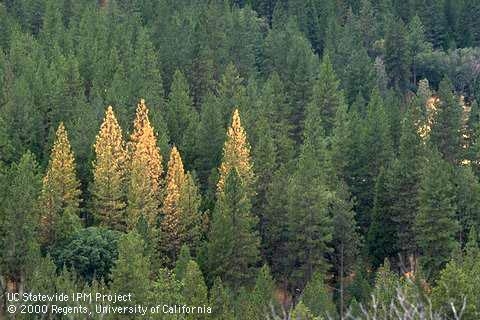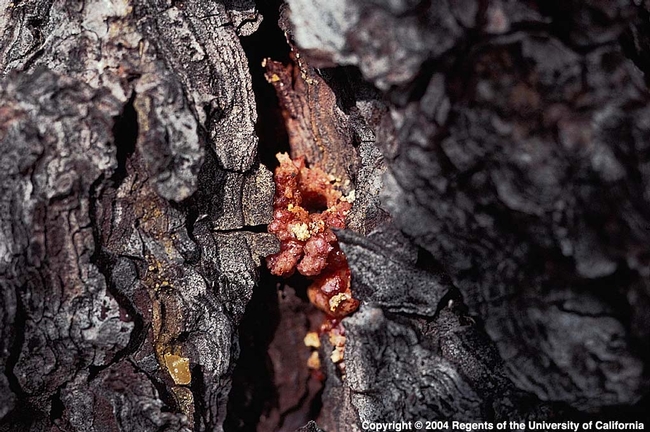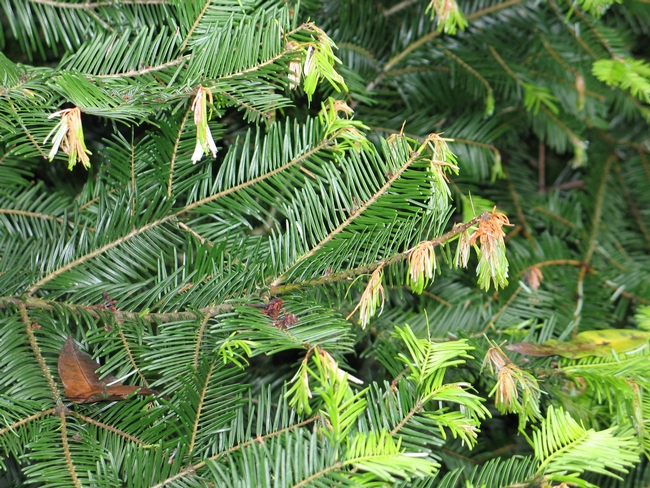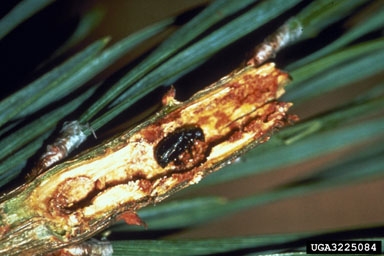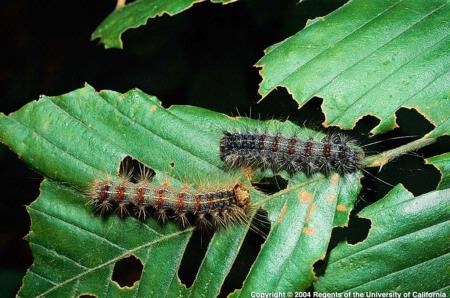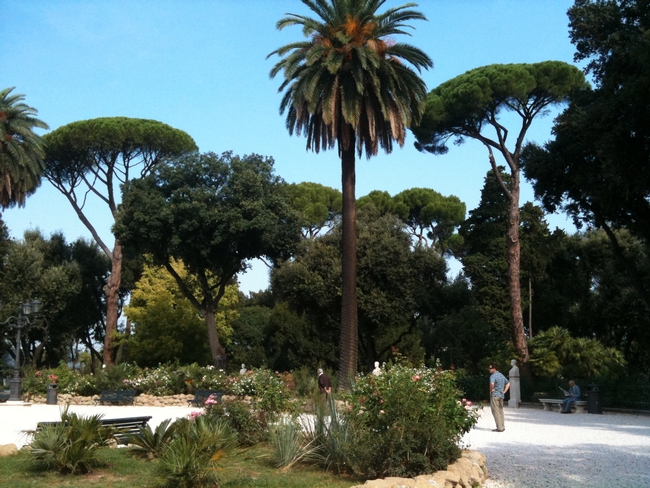Posts Tagged: pine
Forest and tree health in a time of drought
The fourth winter in a row of disappointing precipitation has triggered a die off of trees in the Sierra Nevada, most of which is now in ‘exceptional drought' status. The US Forest Service conducted aerial monitoring surveys by airplane in April 2015 and observed a large increase in tree mortality in the Southern Sierra (from Sonora south). Surveyors flew over 4.1 million acres of public and private forest land and found that about 20 percent had tree mortality on it, totaling over 10 million dead trees.
The Forest Service found severe mortality in many pine species especially ponderosa pine. On private lands along the foothills of the Sierras, surveyors found extensive areas of dead pines. Large areas of blue and live oak mortality were also suspected though it was too early in the season to be sure.
On the Stanislaus National Forest, areas with dead trees doubled since last year. Pine mortality, mostly caused by western pine beetle, was common at lower elevations. Over 5 million trees were killed on the Sierra and Sequoia National Forests up from the 300,000 trees killed last year in the same area. Conifer mortality was scattered at higher elevation, though surveyors note that the survey was conducted too early in the year to detect the full extent of mortality levels.
The insects killing trees in the Sierra are all native insects that are multiplying because of drought conditions. Native insects are a necessary part of the forest ecosystem that speed decay of wood back into nutrients, prey on other insects, and provide food for wildlife. They are normally present at low levels and cause tree mortality only in localized areas.
However, drought weakens trees and reduces their ability to withstand insect attacks. Normally trees use pitch to expel beetles that attempt to burrow into the tree through the bark. Weakened trees cannot produce the pitch needed to repel these beetles which are able to enter under the bark and lay eggs. Larvae feed on a tree's inner bark cutting off the tree's ability to transport nutrients and eventually kill it. Attacking beetles release chemicals called pheromones that attract other beetles until a mass attack overcomes the tree. Many beetles also carry fungi that weaken the tree's defenses.
Western pine beetle is one of the main culprits killing pines in the Sierra during this drought. It is a bark beetle, one of a genus of beetles named Dendroctonus which literally means ‘tree-killer'. Adult beetles are dark brown and about a quarter-inch long. Adults bore into ponderosa pines, lay eggs which develop into larvae in the inner bark then complete development in the outer bark. When beetle populations are high, such as during drought periods, even healthy trees may not be able to produce enough pitch to ward off hundreds of beetle attacks.
Western pine beetle often attacks in conjunction with other insects. Other beetles causing tree mortality in Sierra forests include mountain pine beetle, red turpentine beetle, Jeffrey pine beetle, engraver beetles (Ips) and fir engravers. Forests with a higher diversity of tree species are typically less affected because beetles often have a preference for specific tree species. Some species may attack only one tree type. For example Jeffrey pine beetles attack only Jeffrey pine.
The best defense against bark beetles is to keep trees healthy so they are able fight off insects themselves. Widely spaced trees are typically less susceptible to successful attack by bark beetles since they face less competition for moisture, light, and nutrients compared to densely growing and overcrowded trees. Forest health can be promoted by thinning to reduce overcrowding (so each tree has access to more resources) and removing high risk trees during thinning (such as those that are suppressed or unhealthy).
For landscape trees of high value close to a home, watering may be one option to increase tree vigor against bark beetle attacks. Apply about 10 gallons of water for each inch of tree diameter (measured at chest height) around the dripline of the tree once or several times a month during dry weather.
There are some insecticides registered for bark beetle control, but all are preventative only. Carbaryl may prevent attack for up to two years, while pyrethroids can deter attack for up to a year. Spraying can be tricky because the chemical must be applied up to 50 feet up the trunk of the tree usually while standing on the ground. Since misapplication may have toxic consequences, any insecticide must be administered by a licensed pesticide applicator. All applications must follow the label. Though some systemic treatments applied to the soil or inserted into the tree may work in some cases, there is not a lot of documented evidence that they are effective against western pine beetle. No insecticide can prevent tree death once a tree has been successfully attacked.
Author: Susie Kocher, UC Agriculture and Natural Resources Cooperative Extension advisor
Recycling Christmas trees helps curb the spread of pests
If you have a real Christmas tree, University of California pest management experts ask that you to recycle the tree to prevent the spread of insects and diseases that may harm our forests and landscape trees.
“Invasive insects, diseases and plant seeds can move on cut Christmas trees and other holiday greenery,” said Janice Alexander, UC Cooperative Extension forest health educator in Marin County. “These pests can escape out into backyards and neighboring forests to begin new populations, upsetting the balance of our native ecosystems. Proper purchasing and disposal of holiday greenery helps reduce that risk.”
Alexander recommends taking advantage of local tree recycling programs.
“Many municipalities and service organizations offer this service right at your curb,” she said. “If you aren't able to find or use this option, take the tree to your local solid waste facility, dump or landfill. This will keep any pests that might be in the tree from spreading and the landfill uses the material as cover.”
“You should not try to burn the wood indoors as fresh sap can create fire hazards,” she added, “and don't set the tree out in a backyard brush pile where pests and weed seeds could escape onto your property.”
“The most worrisome pests that might be traveling on Christmas trees or greenery this year include P. ramorum, pine shoot beetle and gypsy moth,” Alexander said.
The movement of some fresh trees is regulated. For example, Douglas fir trees are regulated because they are hosts for Phytophthora ramorum, which causes sudden oak death. The disease has killed millions of tanoak trees and several oak tree species in forests throughout California since the mid-1990s.
Pine shoot beetle and gypsy moth are not currently in California, but they could damage the state's Christmas tree plantations and forests if they were to become established.
Pine shoot beetles, Tomicus piniperda, feed on shoots, stunting the growth of pine trees. Large populations of the insects can kill apparently healthy trees.
Gypsy moth, Lymantria dispar, attacks forests and landscape trees, including manzanita, western hemlock, Douglas fir and live oak. Gypsy moth caterpillars feed on hundreds of plant species and are capable of defoliating trees at an alarming rate. A single gypsy moth caterpillar can eat up to one square foot of leaves per day, according to the California Department of Food and Agriculture.
For more information about sudden oak death and forest health, visit Alexander's website at http://cemarin.ucanr.edu/Programs/Custom_Program816. More information about holiday greenery pests can be found at the USDA APHIS website and the Don't Move Firewood website http://www.dontmovefirewood.org/HolidayGreenery.
Mountain pine beetle turns trees into firewood
Tim Paine, professor in the UC Riverside Department of Entomology, discussed wood-boring beetles and wildfires during a six-minute interview on The Madeleine Brand Show, which is broadcast on KPCC, Southern California's public radio affiliate.
Mountain pine beetle is active from northern New Mexico to Northern British Columbia, Paine said.
"It has killed large numbers of trees in the whole range. in some places upwards of 90 percent of the trees are killed by the beetle. Its devastating," Paine said. "You see vast areas of gray ghosts of trees."
Mountain pine beetles bore through the outer bark of the tree and construct their feeding galleries underneath the bark, disrupting water movement through the tree and killing the tree in the process.
Paine said global climate change appears to be extending the mountain pine beetle's range.
"Apparently, in the higher elevations of the Rocky Mountains, temperatures warmed enough that the beetles are advancing up into higher elevations where they weren't before," Paine said.
Though beetles and fire are part of forests' natural eco-system for millennia, the landscape has been changed by long periods of human fire exclusion. Now, when these areas do burn, the fires are more intense than they would have been otherwise.
Stone pines: Quintessentially Italian
Earlier this month, I was lucky enough to spend two weeks touring Italy. It was a glorious trip, filled with pasta, wine, more pasta and more wine. When not eating and drinking, I made a point of noticing the flora. What I noticed was fascinating: What grows wild in Italy is largely the same as what grows wild right here in Solano County. No big surprise, really. We share the Mediterranean climate, and the regions we saw — from Rome to Bologna — are studded with farms and oak chaparral. It felt just like home.
There was one type of tree that stood out, however: the quintessentially Italian stone pines (Pinus pinea). I heard them called “Umbrella Trees” by a tour guide at the Roman Forum. The oldest of these trees stand quite tall, throwing their umbrella-like profile over the ruins in Rome and farmhouses in Tuscany. The trees are most often found along Italy’s two coastlines.
Stone pines are native to the Mediterranean region, and have been cultivated there for at least 6,000 years. The trees are slow growing, but can eventually reach 80 feet in height. Bushy when young, the umbrella-shaped canopy comes along in the trees’ middle age, and can be up to 200 feet in diameter. The cones of stone pines bear delicious pine nuts. Sadly, the western conifer seed bug (Leptoglossus occidentalis) was accidentally imported with timber to northern Italy in the 1990s. The pest has since spread across Europe, feeding on the sap of developing conifer cones. Its sap-sucking causes the developing seeds to wither. It has destroyed most of the pine nut seeds in Italy, and threatens Pinus pinea in its native habitats. Consequently, most pine nuts you see in stores are grown in China.
Lo and behold, stone pines do well in Solano’s climate zones. Before you plant one, check on the pests and disorders of pines in our region at http://www.ipm.ucdavis.edu/PMG/GARDEN/PLANTS/pine.html


